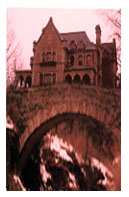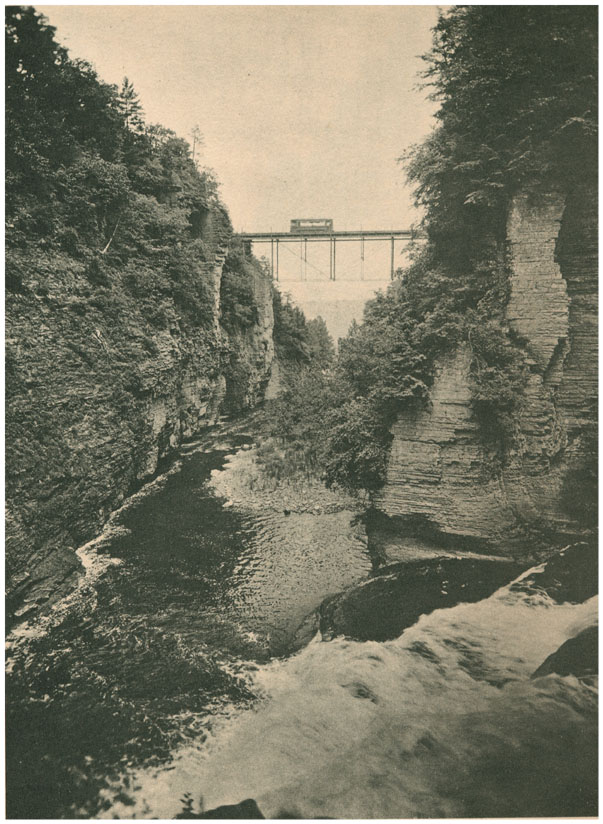




In the eighteen eighties when the Fall Creek gorge, still isolated Ezra Cornell's high old pasture between the gorges, Cornell University held a design competition, open to persons of all degrees and of any nation, for a bridge to cross the gorge. This would open the forested north bank for, fraternal lodges and faculty homes there among the miniatrue, side gorges which carve Cornell and Cayuga heights into neat little kingdoms, componds, and retreats.
But and however, a Cornell Architectural student by the name of Oliver Fast, had submitted designs for a stone bridge, which was to cross Fall Creek slightly up the gorge from where the present bridge is, but at the narowing of the gorge where there was less of a challange to engineers
The stone bridge proposed by Oliver Fast would have classrooms and offices built into it. The Ponte Vecchio of Florence was the obvious model, though his inspiration might been more his dogged, dogmai and maybe overstated principle of what he called "Deep Beauty,"
For all of that intenitonal utillity and inerest, there was maybe something inelegant and impractical about the building.
Heavy and archaic, certianly. Certianly too retro for an age caught up in improvements to human comfort and ease, but . e can at least say, in praise of his bridge, that it was superior to the one adopted by the University, in that it crossed the gorge where it was convient for the bridge, rather than where it was most damatic and best served speed and human ease..
Oliver thought fast and acted slow, sometimes not at all, sometimes in stubborn or strangely eruptive, or impusive for such a stern seeming young man, and would never be ruled by his or anyone else's desire for comfort.
After Fast graduated from Cornell, he practiced for two years with the architect Clinton Vivian, during which employment he worked on the Edgewood Place house which later became the bed and breakfast. After working with Vivian, O. Swift sgepped out on his own to specialize in building fraternity and sororrity houses, favoring stones, arches, dungeons and towers.
But beyond all other things he applied himself stubbornly over a period of thirty years to building with his own hands a one third scale version of the orginal Bridge Plan.
This smaller bridge spanned one of several little gorges that cuts through what is now called Cornell Heights to the North East of campus. He dug the basements himself, did all the bracing, and devised a water powered pump to try to keep the bottom levels dry.
Because because he was obsessed and dogged from morning to night this was not one of those one-man castles which are never finished. He did it just about all by himself, and he finished it. But once he finished the castle, it became painfully apparant just what was wrong. It was quite empty.
His ensuing depression, led him to try suicide by jumping off his bridge, but the jump was not fatal, as it would have been had he been jumping from the original plan.
But and however, what was unsucessfully as suicide certainly suceeded in giving his heart a change of mood. Though crippled the rest of his life, he imported a handy couple from Glasgow who did all that was necessary to look after him and the house while he, though confined to where he could go with his chairs and a series of blocks and tackle he had rigged to the turrents, hauled himself about quite happily, developiing this way a strikingly healthy upper body, a complexion as rosy as a farmer's and a voracious appetite, which gratified the cook, and would have done justice to one of the Bridge House late night breakfasts served in more recent times.
BHe died comfortablly there. Bridge house survived him and other owners and residents, most notably the actress- entrepener, Cameo (Camile Brown/Braun) White. .
After the dog days of her rule, Bridge House - again without support - was donated to the University, which used it in a series of incarnations as a research, boarding, and scholarship house, then when it was plagued by a flu- like syndrome, it passed to Cornell Plantations which used its rooms as winter storage for non-hardy potted trees and other plants. The design has always had the advantange of having a long great hall and large doors so you could drive right through and across. Oliver Fast had made sure that his bridge was really a bridge, so that is good.
In recent years the building had been infiltrated by racoons, which were found to be living in some extradorinarily human and cultured ways.....a situation which was siezed upon by an animal behaviorist doing a thesis on animal culture, for a PHD study.
This got some publicity and was toleaarted by the University for the length of the experiement.
It was during that time that Bridge House first began operating informally as a sort of bed and breakfast run by the racoon researcher Estrelda Stradarus and a certian one William Warren who she had found living in in the house among the racoons.



